Political party strength in U.S. states
Political party strength in U.S. states is the level of representation of the various political parties of the United States in each statewide elective office providing legislators to the state and to the U.S. Congress and electing the executives at the state (U.S. state governor) and national (U.S. President) level.
History
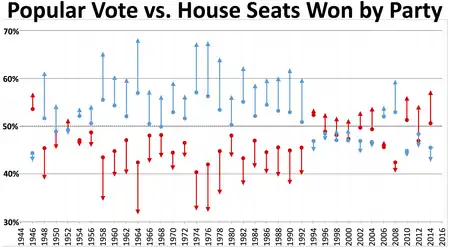
Throughout most of the 20th century, although the Republican and Democratic parties alternated in power at a national level, some states were so overwhelmingly dominated by one party that nomination was usually tantamount to election. This was especially true in the Solid South, where the Democratic Party was dominant for the better part of a century, from the end of Reconstruction in the late 1870s, through the period of Jim Crow Laws into the 1960s. Conversely, the New England states of Vermont, Maine, and New Hampshire were dominated by the Republican Party, as were some Midwestern states like Iowa and North Dakota.
However, in the 1970s and 1980s the increasingly conservative Republican Party gradually overtook the Democrats in the southeast. The Democrats' support in the formerly Solid South had been eroded during the vast cultural, political and economic upheaval that surrounded the 1960s. By the 1990s, the Republican Party had completed the transition into the southeast's dominant political party, despite typically having fewer members due to the prevalence of Republican voting generational Democrats. In New England, the opposite trend occurred; the former Republican strongholds of Maine and Vermont became solidly Democratic, as did formerly Republican areas of New Jersey, New York, and Connecticut.
As of 2020, the majority of the overall number of seats held in the state legislatures has been switching between the two parties every few years. In the U.S. state legislative elections of 2010, the Republican party held an outright majority of 3,890 seats (53% of total) compared to the Democratic party's 3,450 (47% of total) seats elected on a partisan ballot.[1] Of the 7,382 seats in all of the state legislatures combined, independents and third parties account for only 16 members, not counting the 49 members of the Nebraska Legislature, which is the only legislature in the nation to hold non-partisan elections to determine its members. As a result of the 2010 elections, Republicans took control of an additional 19 state legislative chambers, giving them majority control of both chambers in 25 states versus the Democrats' majority control of both chambers in only 16 states, with 8 states having split or inconclusive control of both chambers (not including Nebraska); previous to the 2010 elections, it was Democrats who controlled both chambers in 27 states versus the Republican party having total control in only 14 states, with eight states divided and Nebraska being nonpartisan.[2]
Current party strength
Gallup
On December 17, 2020, Gallup polling found that 31% of Americans identified as Democrats, 25% identified as Republican, and 41% as Independent.[3] Additionally, polling showed that 50% are either "Democrats or Democratic leaners" and 39% are either "Republicans or Republican leaners" when Independents are asked "do you lean more to the Democratic Party or the Republican Party?"[3]
In 2018, the number of competitive states according to opinion polling dropped down to 10, the lowest number since 2008. From 2017 to 2018, New Hampshire, Nevada, and Pennsylvania moved from competitive to lean Democratic, while West Virginia, Louisiana, and Indiana moved from competitive to lean Republican, and Nebraska moved from lean Republican to competitive.[4]
As of 2018, Massachusetts was the most Democratic state, with 56% of residents identifying as Democrat, while only 27% of residents identified as Republican. It is important to note however, that Washington D.C. (while not a state) has 3 electoral votes and 76% of residents identify as Democrats vs the 6% that identify as Repubicans. Wyoming was the most Republican state, with 59% of residents identifying as Republican, and only 25% of residents identifying as Democratic.[4]
| Number of U.S. States | ||||||
|---|---|---|---|---|---|---|
| Year | Solid Dem | Lean Dem | Competitive | Lean GOP | Solid GOP | Net Dem |
| 2008 | 29 | 6 | 10 | 1 | 4 | +30 |
| 2009 | 23 | 10 | 12 | 1 | 4 | +28 |
| 2010 | 13 | 9 | 18 | 5 | 5 | +12 |
| 2011 | 11 | 7 | 15 | 7 | 10 | +1 |
| 2012 | 13 | 6 | 19 | 3 | 9 | +7 |
| 2013 | 12 | 5 | 19 | 2 | 12 | +3 |
| 2014 | 11 | 6 | 18 | 5 | 10 | +2 |
| 2015 | 11 | 3 | 16 | 8 | 12 | −6 |
| 2016 | 13 | 1 | 15 | 7 | 14 | −7 |
| 2017 | 15 | 4 | 15 | 3 | 13 | +3 |
| 2018 | 14 | 8 | 10 | 5 | 13 | +4 |
Cook Partisan Voting Index (PVI)

Another metric measuring party preference is the Cook Partisan Voting Index (PVI). Cook PVIs are calculated by comparing a state's average Democratic Party or Republican Party share of the two-party presidential vote in the past two presidential elections to the nation's average share of the same. PVIs for the states over time can be used to show the trends of U.S. states towards, or away from, one party or the other.[6]
Voter registration and state political control
The state Democratic or Republican Party controls the governorship, the state legislative houses, and U.S. Senate representation. Nebraska's legislature is unicameral, i.e., it has only one legislative house and is officially non-partisan, though party affiliation still has an unofficial influence on the legislative process.
The simplest measure of party strength in a state voting population is the affiliation totals from voter registration (from the websites of the Secretaries of State or state Boards of Elections) for the 30 states and the District of Columbia as of 2019 that allow registered voters to indicate a party preference when registering to vote. 20 states (mostly in the South, Midwest, and Northwest) do not include party preference with voter registration: Alabama, Arkansas, Georgia, Hawaii, Illinois, Indiana, Michigan, Minnesota, Mississippi, Missouri, Montana, North Dakota, Ohio, South Carolina, Tennessee, Texas, Vermont, Virginia, Washington and Wisconsin. The party affiliations in the party control table are obtained from state party registration figures where indicated.[7] Only Wyoming has a majority of registered voters identifying themselves as Republicans; two states have a majority of registered voters identifying themselves as Democrats: Maryland and Kentucky (since 2010, Louisiana, Pennsylvania and West Virginia have all seen their Democratic majority slip to pluralities).
For those states that do not allow for registration by party, Gallup's annual polling of voter party identification by state is the next best metric of party strength in the U.S. states. The partisan figures in the table for the 20 states that don't register voters by party come from Gallup's poll.
U.S. state party control as of January 2021
| State | 2020 presidential election |
Governor | State Senate | State House | Senior U.S. Senator |
Junior U.S. Senator |
U.S. House of Representatives | Party registration or identification (% as of 2020) |
|---|---|---|---|---|---|---|---|---|
| Alabama | Republican | Republican | Republican 27–8 | Republican 77–28 | Republican | Republican | Republican 6–1 | Republican 52–35[lower-alpha 1] |
| Alaska | Republican | Republican | Republican 13–7 | Coalition 23–17[lower-alpha 2] | Republican | Republican | Republican | Republican 24–13[lower-alpha 3][9] |
| Arizona | Democratic | Republican | Republican 16–14 | Republican 31–29 | Democratic | Democratic | Democratic 5–4 | Republican 35–33[lower-alpha 3][10] |
| Arkansas | Republican | Republican | Republican 28–7 | Republican 77–23 | Republican | Republican | Republican 4 | Republican 48–35[lower-alpha 1] |
| California | Democratic | Democratic | Democratic 31–9 | Democratic 59–19–1 | Democratic | Democratic | Democratic 42–11 | Democratic 45–24[lower-alpha 3][11] |
| Colorado | Democratic | Democratic | Democratic 20–15 | Democratic 41–24 | Democratic | Democratic | Democratic 4–3 | Democratic 30–28[lower-alpha 3][12] |
| Connecticut | Democratic | Democratic | Democratic 24–12 | Democratic 97–54 | Democratic | Democratic | Democratic 5 | Democratic 37–21[lower-alpha 3][13] |
| Delaware | Democratic | Democratic | Democratic 14–7 | Democratic 26–15 | Democratic | Democratic | Democratic | Democratic 48–28[lower-alpha 3][14] |
| Florida | Republican | Republican | Republican 24–16 | Republican 78–42 | Republican | Republican | Republican 16–11 | Democratic 37–35[lower-alpha 3][15] |
| Georgia | Democratic | Republican | Republican 34–22 | Republican 103–77 | Democratic | Democratic | Republican 8-6 | Democratic 43–42[lower-alpha 1] |
| Hawaii | Democratic | Democratic | Democratic 24–1 | Democratic 47–4 | Democratic | Democratic | Democratic 2 | Democratic 54–29[lower-alpha 1] |
| Idaho | Republican | Republican | Republican 28–7 | Republican 58–12 | Republican | Republican | Republican 2 | Republican 54-14[lower-alpha 3][16] |
| Illinois | Democratic | Democratic | Democratic 41–18 | Democratic 73–45 | Democratic | Democratic | Democratic 13–5 | Democratic 50–34[lower-alpha 1] |
| Indiana | Republican | Republican | Republican 39–11 | Republican 71–29 | Republican | Republican | Republican 7–2 | Republican 46–38[lower-alpha 1] |
| Iowa | Republican | Republican | Republican 32–18 | Republican 59–41 | Republican | Republican | Republican 3–1 | Even 32–32[lower-alpha 3][17] |
| Kansas | Republican | Democratic | Republican 29–11[lower-alpha 4] | Republican 86–39 | Republican | Republican | Republican 3–1 | Republican 44–25[lower-alpha 3][18] |
| Kentucky | Republican | Democratic | Republican 30–8 | Republican 75–25 | Republican | Republican | Republican 5–1 | Democratic 48–43[lower-alpha 3][19] |
| Louisiana | Republican | Democratic | Republican 27–12 | Republican 68–35–2[lower-alpha 4] | Republican | Republican | Republican 5–1 | Republican 42–32[lower-alpha 3][20] |
| Maine | Democratic/ Republican (2nd District) | Democratic | Democratic 22–13 | Democratic 80–67–4[lower-alpha 4] | Republican | Independent[lower-alpha 5] | Democratic 2 | Democratic 33–27[lower-alpha 3][21] |
| Maryland | Democratic | Republican | Democratic 32–15 | Democratic 99–42 | Democratic | Democratic | Democratic 7-1 | Democratic 55–25[lower-alpha 3][22] |
| Massachusetts | Democratic | Republican | Democratic 37–3 | Democratic 129–30–1[lower-alpha 4] | Democratic | Democratic | Democratic 9 | Democratic 33–10[lower-alpha 3][23] |
| Michigan | Democratic | Democratic | Republican 22–16 | Republican 58–52 | Democratic | Democratic | Tied 7–7 | Democratic 45–39[lower-alpha 1] |
| Minnesota | Democratic | Democratic | Republican 34–31–2 | Democratic 70–64 | Democratic | Democratic | Tied 4–4 | Democratic 46–38[lower-alpha 1] |
| Mississippi | Republican | Republican | Republican 36–16 | Republican 75–44–3[lower-alpha 4] | Republican | Republican | Republican 3–1 | Republican 48–36[lower-alpha 1] |
| Missouri | Republican | Republican | Republican 24–10 | Republican 116–47 | Republican | Republican | Republican 6–2 | Republican 47–38[lower-alpha 1] |
| Montana | Republican | Republican | Republican 31–19 | Republican 67–33 | Democratic | Republican | Republican | Republican 46–39[lower-alpha 1] |
| Nebraska | Republican/ Democratic (2nd District) | Republican | Unicameral Nonpartisan Legislature[lower-alpha 6](De facto Republican 32–17) | Republican | Republican | Republican 3 | Republican 48–30[lower-alpha 3][24] | |
| Nevada | Democratic | Democratic | Democratic 12–9 | Democratic 26–16 | Democratic | Democratic | Democratic 3–1 | Democratic 39–33[lower-alpha 3][25] |
| New Hampshire | Democratic | Republican | Republican 14–10 | Republican 213–187 | Democratic | Democratic | Democratic 2 | Democratic 32–30[lower-alpha 3][26] |
| New Jersey | Democratic | Democratic | Democratic 25–15 | Democratic 52–28 | Democratic | Democratic | Democratic 10-2 | Democratic 38–22[lower-alpha 3][27] |
| New Mexico | Democratic | Democratic | Democratic 27–15 | Democratic 45–25 | Democratic | Democratic | Democratic 2–1 | Democratic 46–30[lower-alpha 3][28] |
| New York | Democratic | Democratic | Democratic 43–20 | Democratic 106–43–1[lower-alpha 4] | Democratic | Democratic | Democratic 19–7[lower-alpha 4][lower-alpha 7] | Democratic 51-22[lower-alpha 3][30] |
| North Carolina | Republican | Democratic | Republican 28–22 | Republican 69–51 | Republican | Republican | Republican 9–5 | Democratic 36–30[lower-alpha 3][31] |
| North Dakota | Republican | Republican | Republican 40–7 | Republican 80–14 | Republican | Republican | Republican | Republican 55-30[lower-alpha 1] |
| Ohio | Republican | Republican | Republican 25–8 | Republican 64–35 | Democratic | Republican | Republican 12–4 | Republican 45–41[lower-alpha 1] |
| Oklahoma | Republican | Republican | Republican 39–9 | Republican 82–19 | Republican | Republican | Republican 5 | Republican 48–35[lower-alpha 3][32] |
| Oregon | Democratic | Democratic | Democratic 18–12 | Democratic 37–23 | Democratic | Democratic | Democratic 4–1 | Democratic 35–25[lower-alpha 3][33] |
| Pennsylvania | Democratic | Democratic | Republican 28–21–1 | Republican 112–90 | Democratic | Republican | Tied 9–9 | Democratic 48–38[lower-alpha 3][34] |
| Rhode Island | Democratic | Democratic | Democratic 33–5 | Democratic 65–10 | Democratic | Democratic | Democratic 2 | Democratic 36–11[lower-alpha 3][35] |
| South Carolina | Republican | Republican | Republican 30–16 | Republican 81–43 | Republican | Republican | Republican 6–1 | Republican 47-37[lower-alpha 1] |
| South Dakota | Republican | Republican | Republican 32–3 | Republican 62–8 | Republican | Republican | Republican | Republican 48–28[lower-alpha 3][36] |
| Tennessee | Republican | Republican | Republican 27–6 | Republican 73–26 | Republican | Republican | Republican 7–2 | Republican 48–35[lower-alpha 1] |
| Texas | Republican | Republican | Republican 18–13 | Republican 83–67 | Republican | Republican | Republican 23–13 | Republican 42–39[lower-alpha 1] |
| Utah | Republican | Republican | Republican 23–6 | Republican 58–17 | Republican | Republican | Republican 4 | Republican 51–15[lower-alpha 3][37] |
| Vermont | Democratic | Republican | Democratic 21–7–2[lower-alpha 4] | Democratic 93–45–7–5[lower-alpha 4] | Democratic | Independent[lower-alpha 5] | Democratic | Democratic 55–30[lower-alpha 1] |
| Virginia | Democratic | Democratic | Democratic 21–18[lower-alpha 4] | Democratic 55–45 | Democratic | Democratic | Democratic 7–4 | Democratic 46–39[lower-alpha 1] |
| Washington | Democratic | Democratic | Democratic 28–21 | Democratic 57–41 | Democratic | Democratic | Democratic 7–3 | Democratic 50–35[lower-alpha 1] |
| West Virginia | Republican | Republican | Republican 23–11 | Republican 76–24 | Democratic | Republican | Republican 3 | Democratic 39–34[lower-alpha 3][38] |
| Wisconsin | Democratic | Democratic | Republican 21–12 | Republican 61–38 | Republican | Democratic | Republican 5–3 | Even 43–43[lower-alpha 1] |
| Wyoming | Republican | Republican | Republican 28–2 | Republican 51–7–1–1 | Republican | Republican | Republican | Republican 70–18[lower-alpha 3][39] |
| Totals | |||||
|---|---|---|---|---|---|
| Presidency (after 2020 Election) |
U.S. Senate (after 2020-21 Elections) |
U.S. House of Representatives (January 2020) |
Governor (after 2020 Elections) |
Majority in State Senate (after 2019 Elections) |
Majority in State House (after 2019 Elections) |
| Democratic 306–232 | Democratic 50–50[lower-alpha 5] | Democratic 222–211[lower-alpha 7] | Republican 27-23 | Republican 31–19 | Republican 28–20–1[lower-alpha 4] |
- Indicated partisan breakdown numbers are from the Party Identification by State figures for 2018 from Gallup polling (note: Gallup figures have been rounded to two significant figures on the assumption that figures from polling are less accurate than registration-by-party figures).[8]
- The Alaska House of Representatives is controlled by a coalition of 15 Democrats, 6 Republicans and 2 Independents.
- Indicated partisan breakdown numbers are from the registration-by-party figures ("active" registered voters, when applicable) from that state's registered voter statistics (early 2020 party registration figures provided whenever possible).
- Vacancy
- Senators Bernie Sanders (I-VT) and Angus King (I-ME) are independents; however, they caucus with Senate Democrats and, as such, are included in that party's total number of Senators for the purposes of calculating partisan breakdown in this article.
- While the Nebraska Legislature is technically non-partisan, the majority of its Senators are de facto Republicans.
- The US House of Representatives currently consists of 222 Democrats and 211 Republicans, and 2 seats are vacant: NY-22, which is still counting; LA-5, which elected Republican Luke Letlow, who died before assuming office.[29]
Party strength by region
Local and regional political circumstances often influence party strength.
State government
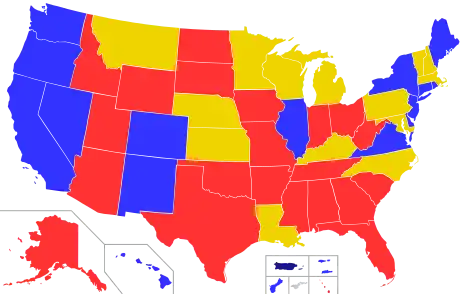
Governors as of January 4, 2021:
| Governor |
|---|
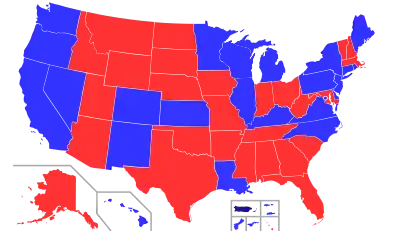 |
Party control of state legislative chambers as of January 2020:
| State Senate | State House |
|---|---|
 |
 |
Presidential election results and congressional delegations
Results of the 2020 Presidential election:
| Presidential Election |
|---|
 |
Current standings in the U.S. Senate and in the U.S. House as of the 117th Congress:
| Senate | House of Representatives |
|---|---|
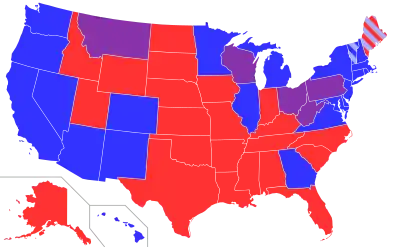 |
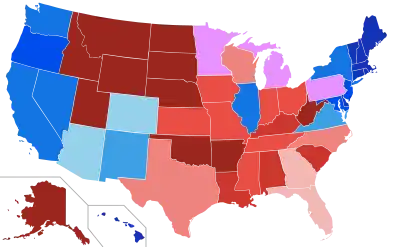 |
Demographics
| U.S. party percentages by state (2017)[40] |
|---|
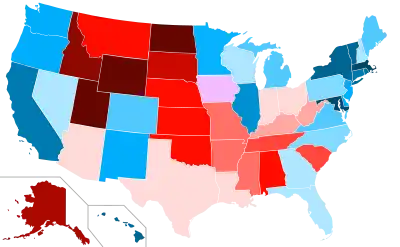 |
Historical party strength
Number of state legislatures controlled by each party.[41]
| Year | Democrats | Republicans | Split |
|---|---|---|---|
| 1938 | 21 | 19 | 6 |
| 1940 | 21 | 17 | 8 |
| 1942 | 19 | 24 | 3 |
| 1944 | 19 | 24 | 3 |
| 1946 | 17 | 25 | 4 |
| 1948 | 19 | 16 | 11 |
| 1950 | 19 | 21 | 6 |
| 1952 | 16 | 26 | 4 |
| 1954 | 19 | 20 | 7 |
| 1956 | 22 | 19 | 5 |
| 1958 | 30 | 7 | 11 |
| 1960 | 27 | 15 | 6 |
| 1962 | 25 | 17 | 6 |
| 1964 | 32 | 6 | 10 |
| 1966 | 23 | 16 | 9 |
| 1968 | 20 | 20 | 8 |
| 1970 | 23 | 16 | 9 |
| 1972 | 26 | 16 | 7 |
| 1974 | 37 | 4 | 8 |
| 1976 | 35 | 4 | 10 |
| 1978 | 31 | 11 | 7 |
| 1980 | 29 | 15 | 5 |
| 1982 | 34 | 11 | 4 |
| 1984 | 26 | 11 | 12 |
| 1986 | 28 | 9 | 12 |
| 1988 | 29 | 8 | 12 |
| 1990 | 30 | 6 | 13 |
| 1992 | 25 | 8 | 16 |
| 1994 | 18 | 19 | 12 |
| 1996 | 20 | 18 | 11 |
| 1998 | 20 | 17 | 12 |
| 2000 | 16 | 18 | 15 |
| 2002 | 18 | 17 | 14 |
| 2003 | 16 | 21 | 12 |
| 2004 | 17 | 21 | 11 |
| 2005 | 20 | 20 | 9 |
| 2007 | 24 | 16 | 9 |
| 2008 | 23 | 15 | 12 |
| 2009 | 27 | 15 | 8 |
| 2010 | 27 | 15 | 8 |
| 2011 | 15 | 27 | 8 |
| 2012 | 15 | 29 | 6 |
| 2013 | 17 | 28 | 5 |
| 2014 | 17 | 28 | 5 |
| 2015 | 11 | 31 | 8 |
| 2016 | 11 | 31 | 8 |
| 2017 | 12 | 32 | 6 |
| 2018 | 13 | 32 | 5 |
| 2019 | 18 | 30 | 2 |
| 2020 | 19 | 29 | 2 |
State governorships controlled by each party.[41]
| Year | Democrats | Republicans | Independent |
|---|---|---|---|
| 1922 | 26 | 22 | |
| 1923 | 27 | 21 | |
| 1924 | 23 | 25 | |
| 1926 | 20 | 28 | |
| 1927 | 19 | 29 | |
| 1928 | 16 | 32 | |
| 1930 | 24 | 22 | 2 |
| 1931 | 26 | 20 | 2 |
| 1932 | 36 | 10 | 2 |
| 1934 | 37 | 9 | 2 |
| 1936 | 38 | 7 | 3 |
| 1937 | 39 | 6 | 3 |
| 1938 | 29 | 19 | |
| 1940 | 28 | 20 | |
| 1942 | 24 | 24 | |
| 1943 | 22 | 26 | |
| 1944 | 25 | 23 | |
| 1946 | 23 | 25 | |
| 1947 | 24 | 24 | |
| 1948 | 28 | 20 | |
| 1950 | 22 | 26 | |
| 1952 | 18 | 30 | |
| 1953 | 19 | 29 | |
| 1954 | 27 | 21 | |
| 1956 | 28 | 20 | |
| 1958 | 35 | 15 | |
| 1960 | 34 | 16 | |
| 1962 | 34 | 16 | |
| 1964 | 33 | 17 | |
| 1966 | 25 | 25 | |
| 1967 | 24 | 26 | |
| 1968 | 19 | 31 | |
| 1969 | 18 | 32 | |
| 1970 | 29 | 21 | |
| 1971 | 30 | 20 | |
| 1972 | 31 | 19 | |
| 1973 | 32 | 18 | |
| 1974 | 36 | 13 | 1 |
| 1976 | 37 | 12 | 1 |
| 1978 | 32 | 18 | |
| 1979 | 31 | 19 | |
| 1980 | 27 | 23 | |
| 1982 | 34 | 16 | |
| 1983 | 35 | 15 | |
| 1984 | 34 | 16 | |
| 1986 | 26 | 24 | |
| 1988 | 28 | 22 | |
| 1989 | 29 | 21 | |
| 1990 | 28 | 20 | 2 |
| 1992 | 30 | 18 | 2 |
| 1993 | 29 | 19 | 2 |
| 1994 | 19 | 30 | 1 |
| 1995 | 18 | 31 | 1 |
| 1996 | 17 | 32 | 1 |
| 1998 | 17 | 31 | 2 |
| 1999 | 18 | 30 | 2 |
| 2000 | 19 | 29 | 2 |
| 2001 | 21 | 27 | 2 |
| 2002 | 24 | 26 | |
| 2004 | 22 | 28 | |
| 2006 | 28 | 22 | |
| 2008 | 29 | 21 | |
| 2009 | 26 | 24 | |
| 2010 | 26 | 23 | 1 |
| 2011 | 20 | 29 | 1 |
| 2012 | 20 | 29 | 1 |
| 2013 | 20 | 30 | |
| 2014 | 21 | 29 | |
| 2015 | 18 | 31 | 1 |
| 2016 | 18 | 31 | 1 |
| 2017 | 15 | 34 | 1 |
| 2018 | 16 | 33 | 1 |
| 2019 | 23 | 27 | |
| 2020 | 24 | 26 |
State government full or split control, by party.
| Year | Democrats | Republicans | Split |
|---|---|---|---|
| 1977 | 27 | 1 | 22 |
| 1978 | 27 | 1 | 22 |
| 1979 | 19 | 5 | 26 |
| 1980 | 18 | 5 | 27 |
| 1981 | 16 | 8 | 26 |
| 1982 | 16 | 8 | 26 |
| 1983 | 24 | 4 | 22 |
| 1984 | 24 | 4 | 22 |
| 1985 | 17 | 4 | 29 |
| 1986 | 17 | 4 | 29 |
| 1987 | 15 | 7 | 28 |
| 1988 | 14 | 6 | 30 |
| 1989 | 15 | 5 | 30 |
| 1990 | 16 | 5 | 29 |
| 1991 | 16 | 3 | 31 |
| 1992 | 15 | 3 | 32 |
| 1993 | 18 | 3 | 29 |
| 1994 | 16 | 4 | 30 |
| 1995 | 8 | 15 | 27 |
| 1996 | 6 | 14 | 30 |
| 1997 | 5 | 12 | 33 |
| 1998 | 5 | 13 | 32 |
| 1999 | 8 | 15 | 27 |
| 2000 | 9 | 16 | 25 |
| 2001 | 8 | 14 | 28 |
| 2002 | 9 | 12 | 29 |
| 2003 | 8 | 12 | 30 |
| 2004 | 8 | 12 | 30 |
| 2005 | 8 | 12 | 30 |
| 2006 | 8 | 12 | 30 |
| 2007 | 15 | 10 | 25 |
| 2008 | 14 | 10 | 26 |
| 2009 | 18 | 10 | 22 |
| 2010 | 17 | 10 | 23 |
| 2011 | 11 | 22 | 17 |
| 2012 | 11 | 24 | 15 |
| 2013 | 13 | 25 | 12 |
| 2014 | 13 | 24 | 13 |
| 2015 | 7 | 24 | 19 |
| 2016 | 7 | 23 | 20 |
| 2017 | 5 | 25 | 20 |
| 2018 | 7 | 25 | 18 |
| 2019 | 14 | 23 | 13 |
| 2020 | 15 | 22 | 13 |
See also
References
- "Republicans Exceed Expectations in 2010 State Legislative Elections". National Conference of State Legislatures. November 3, 2010. Retrieved 2014-12-03.
- Hansen, Karen (December 2010). "Red Tide: December 2010 – A GOP wave washed over state legislatures on Election Day". National Conference of State Legislatures. Retrieved 2014-12-03.
- "Gallup Historical Trends: Party Affiliation". Gallup News. Retrieved 2020-05-14.
In politics, as of today, do you consider yourself a Republican, a Democrat or an independent?
- Inc, Gallup (February 22, 2019). "Democratic States Exceed Republican States by Four in 2018". Gallup.com. Retrieved 2019-10-20.
- Coleman, Miles (December 16, 2016). "2016 State PVI Changes". Decision Desk HQ. Archived from the original on 2018-06-13.
- "Partisan Voter Index by State, 1994–2014" (PDF). The Cook Political Report. 2013. Retrieved 2014-12-23.
- For example, for earlier 2014 registration figures, see: Blumenthal, Mark; Edwards-Levy, Ariel (May 27, 2014). "HUFFPOLLSTER: A State-By-State Guide To Party Registration". Huffington Post. Retrieved 2014-12-23..
- Jones, Jeffrey M (February 22, 2019). "Democratic States Exceed Republican States by Four in 2018". Gallup.com (Press release). Gallup. Retrieved 2020-05-25.
- "Number of Registered Voters by Party Within Precinct". State of Alaska – Division of Elections. May 3, 2020. Retrieved 2020-05-25.
- "Voter Registration & Historical Election Data". Arizona Department of State – Office of the Secretary of State. April 1, 2020. Retrieved 2020-05-25.CS1 maint: date and year (link)
- "Registration by County". Report of Registration - February 18, 2020 (PDF). Sacramento, Calif.: California Secretary of State. February 18, 2020. p. 11. Retrieved 2020-05-20 – via http://www.sos.ca.gov/elections/voter-registration/voter-registration-statistics/.CS1 maint: date and year (link)
- "Total Registered Voters By Party Affiliation and Status" (PDF). Colorado Secretary of State. May 1, 2020. Retrieved 2014-12-20 – via http://www.sos.state.co.us/pubs/elections/VoterRegNumbers/VoterRegNumbers.html.
- "Registration and Party Enrollment Statistics as of October 29, 2019" (PDF). Connecticut Secretary of State. October 29, 2019. Retrieved 2020-05-25 – via https://portal.ct.gov/SOTS/Election-Services/Statistics-and-Data/Statistics-and-Data.
- "Voter Registration Totals by Political Party". State of Delaware – Office of the State Election Commissioner. May 1, 2020. Retrieved 2020-05-25 – via http://elections.delaware.gov/services/candidate/regtotals.shtml.
- "Voter Registration Statistics – By Party Affiliation". Florida Division of Elections. March 31, 2020. Retrieved 2020-05-25.
- Idaho Secretary of State - Voter Registration Totals, June 2020
- "Voter Registration Totals - County" (PDF). Iowa Secretary of State. May 1, 2020. Retrieved 2020-05-25 – via https://sos.iowa.gov/elections/voterreg/regstat.html.
- "2018 General Election – Certified Voter Registration and Party Affiliation Numbers" (XLSX). State of Kansas – Office of the Secretary of State. October 2018. Retrieved 2020-05-25 – via https://sos.kansas.gov/elections/election-statistics/.
- "Voter Registration Statistics Report" (pdf). Commonwealth of Kentucky – State Board of Elections. May 15, 2020. Retrieved 2020-05-25 – via https://elect.ky.gov/Resources/Pages/Registration-Statistics.aspx.
- "Statewide Report of Registered Voters" (PDF). Louisiana Secretary of State. May 1, 2020. Retrieved 2020-05-25 – via http://www.sos.la.gov/ElectionsAndVoting/Pages/RegistrationStatisticsStatewide.aspx.
- "Registered and Enrolled Voters - Statewide" (PDF). State of Maine – Department of the Secretary of State – Bureau of Corporations, Elections and Commissions. December 9, 2019. Retrieved 2020-05-25 – via https://www.maine.gov/sos/cec/elec/data/index.html.
- "Maryland State Board of Elections Summary of Voter Registration Activity Report" (PDF). Maryland.gov – The State Board of Elections. April 2020. Retrieved 2020-05-25 – via https://elections.maryland.gov/voter_registration/stats.html.
- "Enrollment Breakdown as of 02/12/2020" (pdf). The Commonwealth of Massachusetts. February 12, 2020. Retrieved 2020-05-25 – via https://www.sec.state.ma.us/ele/eleregistrationstats/registrationstats.htm.
- "VR Statistics Count Report – Count of Registrants Eligible to Vote" (pdf). Nebraska Secretary of State. May 1, 2020. Retrieved 2020-05-25 – via https://sos.nebraska.gov/elections/voter-registration-statistics.
- "April 2020 Voter Registration Statistics" (PDF). Nevada Secretary of State. April 30, 2020. Retrieved 2020-05-25 – via https://www.nvsos.gov/sos/elections/voters/2020-statistics.
- "Party Registration/Names on Checklist History". State of New Hampshire – Secretary of State – Elections Division. April 1, 2020. Retrieved 2020-05-25.
- "Statewide Voter Registration Summary" (PDF). State of New Jersey – Department of State. May 1, 2020. Retrieved 2014-12-20 – via https://nj.gov/state/elections/election-information-svrs.shtml.CS1 maint: date and year (link)
- "New Mexico Voter Registration Statistics Statewide by County" (pdf). New Mexico Secretary of State. April 30, 2020. Retrieved 2020-05-25 – via https://www.sos.state.nm.us/voting-and-elections/data-and-maps/voter-registration-statistics/.
- "Luke Letlow, US congressman-elect, dies of Covid aged 41". The Guardian. December 30, 2020. Retrieved 2021-01-10.
- "Enrollment by County" (XLSX). New York State – Board of Elections. February 21, 2020. Retrieved 2020-05-25 – via http://www.elections.ny.gov/EnrollmentCounty.html.
- "Voter Registration Statistics". North Carolina State Board of Elections. May 23, 2020. Retrieved 2020-05-25.
- "Current Registration Statistics by County" (pdf). Oklahoma State Election Board. January 15, 2020. Retrieved 2020-05-25 – via http://www.ok.gov/elections/Voter_Info/Voter_Registration_Statistics/index.html.
- "Voter Registration Statistics" (PDF). Oregon Secretary of State. May 4, 2020. Retrieved 2020-05-25 – via http://sos.oregon.gov/elections/Pages/electionsstatistics.aspx.
- "Voter registration statistics by county" (XLSX). Pennsylvania Department of State. May 18, 2020. Retrieved 2020-05-25 – via https://www.dos.pa.gov/VotingElections/OtherServicesEvents/VotingElectionStatistics/Pages/VotingElectionStatistics.aspx.
- "Registration Status of Voters in Rhode Island". Rhode Island Department of State. May 2020. Retrieved 2020-05-25.
- "Voter Registration Tracking". South Dakota Secretary of State. May 1, 2020. Retrieved 2020-05-25.
- Utah Current Voter Registration Statistics, October 26, 2020
- "Voter Registration Totals" (PDF). West Virginia Secretary of State. April 30, 2020. Retrieved 2020-05-25 – via https://sos.wv.gov/elections/Pages/VoteRegTotals.aspx.
- "Wyoming Voter Registration" (pdf). Wyoming Secretary of State. May 1, 2020. Retrieved 2020-05-25 – via https://sos.wyo.gov/elections/vrstats.aspx.
- "2017 U.S. Party Affiliation by State". Gallup.com. Retrieved 2019-05-24.
- "U.S. Census Bureau, The 2012 Statistical Abstract, The National Data Book, Elections: Gubernatorial and State Legislatures (see: Tables 416 and 418)" (PDF). U.S. Census Bureau. August 2011. pp. 260–261. Archived (PDF) from the original on 2017-03-22. Retrieved 2020-05-14 – via https://www.census.gov/library/publications/2011/compendia/statab/131ed/elections.html.